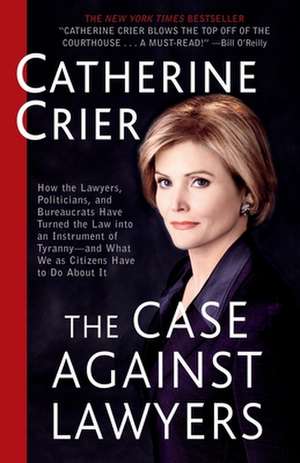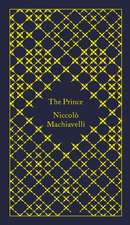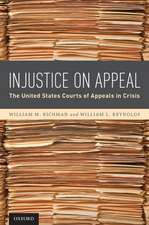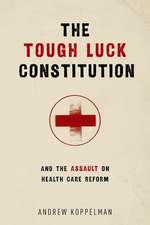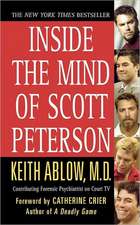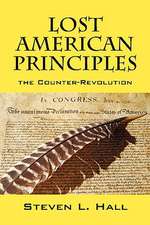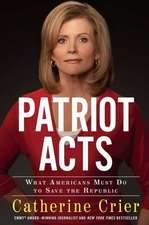The Case Against Lawyers: How the Lawyers, Politicians, and Bureaucrats Have Turned the Law Into an Instrument of Tyranny--And What We as Citize
Autor Catherine Crieren Limba Engleză Paperback – 31 aug 2003
As a child, Catherine Crier was enchanted by film portrayals of crusading lawyers like Clarence Darrow and Atticus Finch. As a district attorney, private lawyer, and judge herself, she saw firsthand how the U.S. justice system worked – and didn’t. One of the most respected legal journalists and commentators today, she now confronts a profoundly unfair legal system that produces results and profits for the few – and paralysis, frustration, and injustice for the many. Alexis de Tocqueville’s dire prediction in Democracy in America has come true: We Americans have ceded our responsibility as citizens to resolve the problems of society to "legal authorities" – and with it our democratic freedoms.
The Case Against Lawyers is both an angry indictment and an eloquent plea for a return to common sense. It decries a system of laws so complex even the enforcers – such as the IRS – cannot understand them. It unmasks a litigation-crazed society where billion-dollar judgments mostly line the pockets of personal injury lawyers. It deplores the stupidity of a system of liability that leads to such results as a label on a stroller that warns, “Remove child before folding.” It indicts a criminal justice system that puts minor drug offenders away for life yet allows celebrity murderers to walk free. And it excoriates the sheer corruption of the iron triangle of lawyers, bureaucrats, and politicians who profit mightily from all this inefficiency, injustice, and abuse.
The Case Against Lawyers will make readers hopping mad. And it will make them realize that the only response can be to demand change. Now.
From the Hardcover edition.
Preț: 111.42 lei
Nou
Puncte Express: 167
Preț estimativ în valută:
21.33€ • 23.17$ • 17.93£
21.33€ • 23.17$ • 17.93£
Carte disponibilă
Livrare economică 31 martie-14 aprilie
Preluare comenzi: 021 569.72.76
Specificații
ISBN-13: 9780767905053
ISBN-10: 0767905059
Pagini: 256
Dimensiuni: 144 x 216 x 17 mm
Greutate: 0.34 kg
Editura: BROADWAY BOOKS
ISBN-10: 0767905059
Pagini: 256
Dimensiuni: 144 x 216 x 17 mm
Greutate: 0.34 kg
Editura: BROADWAY BOOKS
Notă biografică
Catherine Crier currently hosts “Catherine Crier Live” on Court TV. She began her television career as news anchor and talk show host at CNN, went on to win her first Emmy in 1996 for her work as a correspondent on ABC's 20/20, then hosted an issues show for the FOX News Channel. A former lawyer and judge from Dallas, Catherine resides in Westchester County with her dogs and horses.
From the Hardcover edition.
From the Hardcover edition.
Extras
ONE - We Love Our Rules
Sports have always been a favorite metaphor in American life. It is hard to have a conversation with an American male that doesn't include some reference to goals, yard lines, home runs, Hail Marys, you name it. I find an amazing correlation between the way we play our games and the way we live our lives.
Compare many European sporting events with American games. In soccer or rugby, the play is virtually nonstop. There is only one referee on the field. When infractions occur, the ref approximates the site of the foul, the ball is replaced, and play immediately resumes.
In American football, the field is covered with officials on top of every play. Yellow flags fly constantly. Chain markers carefully measure every inch the ball progresses. There are constant timeouts for consultation, even video review of contested plays. The rules are endless. Arguments abound and controversial calls will be examined for years. Thank God there's not a level of appeal beyond the head referee. As it is, a game with sixty playing minutes takes three times as long to finish.
But we love our rules. We think they make a game safer, fairer, and more just. If someone gets injured, it is time to sue the other player, the equipment manufacturer, or the school. If a ref makes a bad call, we need more cameras for the instant replay. We seem unwilling to accept that there will be times when chance, accident, bias, or corruption will defeat the best rules and regulations.
I say, get a life. Let's get on with the game. I find it amazing that people who profess to be so rugged, independent, and free want even our roughest sport to be predictable and safe. The rugby players I know scoff at our wimpy version of football. "Imagine," they say, "if we put those guys on our field and made them play without pads essentially nonstop for an hour. They'd all be dead!"
This is more than a metaphor. This is now the American way of life. Name one thing you did today--after rolling off that mattress (bearing the label "Do not remove under punishment of law"), showering in water with the temperature preset by a boiler manufacturer to prevent scalding, using the hairdryer that warns against electrocution in the bathtub, eating breakfast properly labeled for the allergy or calorie conscious, getting into your car as the seat-belt warning dings, then heading down the road with traffic signs and lights everywhere you turn--that isn't somehow regulated. It's hard to do.
Take a gander at ten of my favorite examples from the annual Wacky Warning Label contest sponsored by Michigan Lawsuit Abuse Watch. Remember, these are all legitimate labels to protect you from yourself:
NUMBER TEN: The label on a handheld massager advises "Do not use while sleeping or unconscious."
NUMBER NINE: A label on a public toilet reads "Recycled flush water unsafe for drinking."
NUMBER EIGHT: A can of self-protection pepper spray warns users "May irritate eyes."
NUMBER SEVEN: No matter how slow the print out, please heed the warning on a laser printer cartridge: "Do not eat toner."
NUMBER SIX: A thirteen-inch wheel on a wheelbarrow warns "Not intended for highway use."
NUMBER FIVE: A label on prescription sleeping pills warns that they "may cause drowsiness."
NUMBER FOUR: A cardboard car sunshield that keeps sun off the dashboard warns "Do not drive with sunshield in place."
NUMBER THREE: Bicycle shin guards warn "Shin pads cannot protect any part of the body they do not cover."
NUMBER TWO: A household iron warns "Never iron clothes while they are being worn" (and don't steam yourself either; I've tried).
And finally, my favorite, and 1999's big winner:
NUMBER ONE: Parents, please read the baby stroller label that cautions "Remove child before folding."
These labels are more than superfluous "information." Most are a response to some lawsuit as courts have expanded the right to be an idiot. Company lawyers, fearing liability, are madly composing such moronic disclaimers while Washington bureaucrats are codifying them as laws. These are our taxpayer dollars at work.
Once two or more people are involved, things only get worse. Whether at work, at school, or in the marketplace, everything is regulated. We have more protective employment laws on the books than ever, yet complaints are at an all-time high. (If you write it, they will sue!) Discrimination and disability rulings now cover every conceivable human variable, exacerbating our differences rather than insuring a specious "equality." Our educational process is monitored by an endless litany of rules for teaching and discipline, yet student performance is abysmal and the kids are out of control. Government regulates our nutrition and foods, while the national girth and associated health problems explode. Every aspect of workplace safety is regulated, yet the number of workplace deaths has been static for years. The safer cars get, the more auto insurers are hit for bodily injuries. Even worse, we have developed a plethora of excuses to justify the most aberrant or plainly stupid behavior. Speed down an icy roadway without your seat belt and relatives still can sue the automaker and hospital when you crash and burn. There is no personal responsibility for asinine conduct.
Litigation is no longer a crapshoot, it is becoming a sure thing. If you can't get a satisfactory nuisance settlement, then try your case; the awards are phenomenal! Human life is now quantified in astronomical terms. In 1999 the ten biggest jury awards to individual plaintiffs totaled almost $9 billion--three times the amount in 1998. One verdict delivered $1.2 billion to the family of thirty-two-year-old Jennifer Cowart. She died of burn injuries after a go-cart accident at an amusement park apparently due to a defective gas cap. The accident was horrific to be sure, but $1.2 billion?
Many of these huge verdicts are reduced on appeal, but it wasn't until 1996 that the U.S. Supreme Court first overturned any punitive damage award for being excessive. The case was against BMW of North America. A fellow bought a new car in 1990 only to discover months later that its surface had been damaged and refinished before sale. The automaker's policy at the time was not to reveal repairs that were less than 3 percent of a car's retail price. In this case, the resurfacing cost $601. The jury, however, awarded $4,000 in compensatory damages and $4 million as punishment for the practice. The Alabama appeals court kindly cut the punitive award to $2 million.
BMW appealed to the U.S. Supreme Court. In his majority opinion, Justice John Paul Stevens found the "damage" to the car had no effect on its performance, safety, or appearance. He then ruled that there should be some fair ratio between the actual and punitive damages. Even at the reduced rate of $2 million, this sum was still 500 times the so-called damage to the car. The case was sent back to the lower court for review with this admonishment: "We are not prepared to draw a bright line marking the limits of a constitutionally acceptable punitive damage award . . . however, we are fully convinced that the grossly excessive award in this case transcends the constitutional limit." (I guess it's sort of like pornography. You know it when you see it.) Ultimately the punitive award was cut to $50,000.
By 2000 these sums were merely peanuts. One fifty-seven-year-old smoker who testified (with a straight face) that he didn't know the dangers of smoking until 1994 was awarded $3 billion against Philip Morris. Upon judicial review, smoker Richard Boeken saw his $3 billion fizzle to a mere $100 million. In March 2002 a jury awarded $150 million to the estate of Michele Schwartz after finding that a tobacco company falsely represented low-tar cigarettes as less dangerous than regular cigarettes. Although Philip Morris argued the company only promised the brands were "milder," the plaintiffs asserted that Schwartz had switched from regular cigarettes because she believed the low-tar version would be better for her health. By the way, Schwartz worked for years for her husband, who just happened to be a doctor. I'm no fan of cigarette manufacturers, but people have certainly known since 1964 when the Surgeon General slapped a warning on smokes that this was a ba-a-ad habit.
In 2000 the $246 billion settlement of state tobacco suits toppled the scales. It has been called the largest redistribution of wealth to the smallest number of people in the history of the world. This payout does not refer to the monies awarded to the sick but the billions that went to a cluster of attorneys for their work on the cases. As much as I hate the product, the lawsuits are ridiculous. We have known for almost forty years what smoking does to the body. Quitting is hard, but we tell illegal drug users to stop or go to prison. Cigarette addicts get money instead! Tobacco litigation has opened the floodgates for creative lawyers now targeting the gun industry. HMOs, nursing homes, and paint companies are on their radar screens. Get ready for the alcohol and fatty foods litigation. It is coming.
This type of litigation has also put dreams of riches into the minds of governors and attorneys general around the country. An incestuous relationship between these officials and private attorneys is growing. Here's how it works. The government decides to attack some "dangerous" industry to protect its citizens. Instead of calling on lawyers already on the state payroll, the officials hire big outside firms--often the same firms that are major contributors to the political campaigns that put and keep the officials in office. These state executives get bragging rights with the voters for lawsuit awards that pump up the general revenue fund, the private attorneys get huge contingency fees, and often some of those fees recycle right back into the campaign coffers for the next election.
But as long as the appellate courts are reducing most excessive verdicts, is there a problem? Yes. These remittances coming long after the awards make headlines do not correct the broader damage to our justice system. Back in 1998 Mark E. Dapier, general counsel to Mercury Finance Company, testified before the Senate Judiciary Committee about these other effects. His company had been sued for "fraudulent suppression" of material information to a consumer. Mercury sold a car loan at a discount to a subsidiary that would collect on the note (a very common practice). When the original car buyer defaulted on the $6,000 note, he sued Mercury, alleging that the failure to reveal this discount was fraud. The initial jury found $90,000 in actual damages and $50 million in punitive damages in a case where the plaintiff suffered no harm!
While the trial judge ultimately reduced the punitive award to $2 million, the defendant's headaches were far from over. When the initial verdict was reported, more suits, some as class actions, cropped up in other states. The original plaintiff's attorney immediately filed nine more identical suits. Fearing more huge awards, Mercury settled many of these cases. Others went through protracted litigation and appeals. Finally, after Mercury obtained several state and federal court rulings that this discounting practice was perfectly legal, the suits stopped. Of course, no one compensated the company for the millions it had spent on legal fees and settlements or the enormous amount of time and energy it had devoted to dozens of lawsuits.
Insurance companies don't wait for any rebate before upping their fees. In 1999 the Oregon Supreme Court refused to put a $500,000 cap on pain and suffering awards in malpractice cases. Almost immediately, juries came back with three multimillion-dollar awards. Insurance rates went up. Mississippi's Hattiesburg American reported in 2002 that a group of emergency doctors "paid $140,000 for malpractice insurance" two years ago. "Last year, the premium went to $250,000." Doctors have been warned that "the next annual premium would be $437,500 or $475,000." An Associated Press article in March reported the immediate result. "The Mississippi Trauma Advisory Committee has suspended re-inspection of its hospitals for a year to give health officials time to address the growing problem of surgeons leaving the system." The hospitals are losing so many specialists that they cannot meet state trauma standards, so the enforcement agency must simply look the other way. "We're in a crisis," said State Health Officer Ed Thompson. This development is being replicated across the country.
Damages for pain and suffering are also soaring, as is our expectation of large payoffs for every tragedy that befalls us. These sums are rarely reduced on appeal. In a U.S. News and World Report piece entitled "How Lawyers Abuse the System," the authors discussed various trial tactics designed to elicit the most melodramatic statements possible. Using the power of suggestion, one attorney asked his client, "Did a false arrest and imprisonment bring back memories of the Holocaust?" People who merely witness an event will line up to recover.
After the terror attack of September 11, the government made a determination, whether right or wrong, that it was necessary to protect the airlines from repeated lawsuits. While we may be able to survive without asbestos or lead paint companies, bankrupting the airlines to satisfy thousands of judgments would not be in the best interests of the nation. Unfortunately, that big-picture consideration has never stopped attorneys and their clients before, so the government legislated limits on those industry suits while trying to fairly compensate victims and their families with taxpayer dollars.
As politically incorrect as this may seem, the families from September 11 who object to the government fund that specifies a set $250,000 in emotional damages and $50,000 for each additional survivor need to ask themselves: Just what would compensate for the psychic loss? If you can name any number, you're way ahead of me. In a February Time magazine piece in 2002, one family objected to these sums by saying "Have you ever seen a twelve-year-old have a nervous breakdown?" Therapy would be covered under actual damages so again, my question is "How much cash will make the pain better?" because for most people, no amount of money will excise the hurt. The sad truth is that thousands of people are killed every year in myriad tragedies, from accidents, to crimes, to terrorist horrors. The shooting victim's family rarely recovers from the robber's attack. The suicide doesn't leave his or her loved ones much room to recover. Which victim is worth hundreds of thousands for suffering relatives and which one is worth absolutely nothing . . . and why?
Moving on, plaintiffs no longer have to show any actual damage to be included in class action suits. One example is the asbestos litigation, where the courts have expanded the right to sue to the point that plaintiffs with only a "likelihood" of becoming ill are collecting. You've heard the commercials: "If you have ever been exposed [not necessarily made ill by] to X, Y or Z call now!" Many people truly suffering from asbestos exposure may never recover a dime as company after company goes belly up paying plaintiffs with no apparent injury. It is interesting to note that plaintiffs' lawyers are now recognizing the need to keep these companies on life support. They try to pace their attacks and awards against certain industries so that they don't destroy them completely. If you hear a plaintiff's lawyer say "We're going to put big tobacco or gun companies out of business," that's just for show. Since there is no notion of double jeopardy in these civil actions, the attorneys can return to feed on these defendants as long as they remain financially viable.
From the Hardcover edition.
Sports have always been a favorite metaphor in American life. It is hard to have a conversation with an American male that doesn't include some reference to goals, yard lines, home runs, Hail Marys, you name it. I find an amazing correlation between the way we play our games and the way we live our lives.
Compare many European sporting events with American games. In soccer or rugby, the play is virtually nonstop. There is only one referee on the field. When infractions occur, the ref approximates the site of the foul, the ball is replaced, and play immediately resumes.
In American football, the field is covered with officials on top of every play. Yellow flags fly constantly. Chain markers carefully measure every inch the ball progresses. There are constant timeouts for consultation, even video review of contested plays. The rules are endless. Arguments abound and controversial calls will be examined for years. Thank God there's not a level of appeal beyond the head referee. As it is, a game with sixty playing minutes takes three times as long to finish.
But we love our rules. We think they make a game safer, fairer, and more just. If someone gets injured, it is time to sue the other player, the equipment manufacturer, or the school. If a ref makes a bad call, we need more cameras for the instant replay. We seem unwilling to accept that there will be times when chance, accident, bias, or corruption will defeat the best rules and regulations.
I say, get a life. Let's get on with the game. I find it amazing that people who profess to be so rugged, independent, and free want even our roughest sport to be predictable and safe. The rugby players I know scoff at our wimpy version of football. "Imagine," they say, "if we put those guys on our field and made them play without pads essentially nonstop for an hour. They'd all be dead!"
This is more than a metaphor. This is now the American way of life. Name one thing you did today--after rolling off that mattress (bearing the label "Do not remove under punishment of law"), showering in water with the temperature preset by a boiler manufacturer to prevent scalding, using the hairdryer that warns against electrocution in the bathtub, eating breakfast properly labeled for the allergy or calorie conscious, getting into your car as the seat-belt warning dings, then heading down the road with traffic signs and lights everywhere you turn--that isn't somehow regulated. It's hard to do.
Take a gander at ten of my favorite examples from the annual Wacky Warning Label contest sponsored by Michigan Lawsuit Abuse Watch. Remember, these are all legitimate labels to protect you from yourself:
NUMBER TEN: The label on a handheld massager advises "Do not use while sleeping or unconscious."
NUMBER NINE: A label on a public toilet reads "Recycled flush water unsafe for drinking."
NUMBER EIGHT: A can of self-protection pepper spray warns users "May irritate eyes."
NUMBER SEVEN: No matter how slow the print out, please heed the warning on a laser printer cartridge: "Do not eat toner."
NUMBER SIX: A thirteen-inch wheel on a wheelbarrow warns "Not intended for highway use."
NUMBER FIVE: A label on prescription sleeping pills warns that they "may cause drowsiness."
NUMBER FOUR: A cardboard car sunshield that keeps sun off the dashboard warns "Do not drive with sunshield in place."
NUMBER THREE: Bicycle shin guards warn "Shin pads cannot protect any part of the body they do not cover."
NUMBER TWO: A household iron warns "Never iron clothes while they are being worn" (and don't steam yourself either; I've tried).
And finally, my favorite, and 1999's big winner:
NUMBER ONE: Parents, please read the baby stroller label that cautions "Remove child before folding."
These labels are more than superfluous "information." Most are a response to some lawsuit as courts have expanded the right to be an idiot. Company lawyers, fearing liability, are madly composing such moronic disclaimers while Washington bureaucrats are codifying them as laws. These are our taxpayer dollars at work.
Once two or more people are involved, things only get worse. Whether at work, at school, or in the marketplace, everything is regulated. We have more protective employment laws on the books than ever, yet complaints are at an all-time high. (If you write it, they will sue!) Discrimination and disability rulings now cover every conceivable human variable, exacerbating our differences rather than insuring a specious "equality." Our educational process is monitored by an endless litany of rules for teaching and discipline, yet student performance is abysmal and the kids are out of control. Government regulates our nutrition and foods, while the national girth and associated health problems explode. Every aspect of workplace safety is regulated, yet the number of workplace deaths has been static for years. The safer cars get, the more auto insurers are hit for bodily injuries. Even worse, we have developed a plethora of excuses to justify the most aberrant or plainly stupid behavior. Speed down an icy roadway without your seat belt and relatives still can sue the automaker and hospital when you crash and burn. There is no personal responsibility for asinine conduct.
Litigation is no longer a crapshoot, it is becoming a sure thing. If you can't get a satisfactory nuisance settlement, then try your case; the awards are phenomenal! Human life is now quantified in astronomical terms. In 1999 the ten biggest jury awards to individual plaintiffs totaled almost $9 billion--three times the amount in 1998. One verdict delivered $1.2 billion to the family of thirty-two-year-old Jennifer Cowart. She died of burn injuries after a go-cart accident at an amusement park apparently due to a defective gas cap. The accident was horrific to be sure, but $1.2 billion?
Many of these huge verdicts are reduced on appeal, but it wasn't until 1996 that the U.S. Supreme Court first overturned any punitive damage award for being excessive. The case was against BMW of North America. A fellow bought a new car in 1990 only to discover months later that its surface had been damaged and refinished before sale. The automaker's policy at the time was not to reveal repairs that were less than 3 percent of a car's retail price. In this case, the resurfacing cost $601. The jury, however, awarded $4,000 in compensatory damages and $4 million as punishment for the practice. The Alabama appeals court kindly cut the punitive award to $2 million.
BMW appealed to the U.S. Supreme Court. In his majority opinion, Justice John Paul Stevens found the "damage" to the car had no effect on its performance, safety, or appearance. He then ruled that there should be some fair ratio between the actual and punitive damages. Even at the reduced rate of $2 million, this sum was still 500 times the so-called damage to the car. The case was sent back to the lower court for review with this admonishment: "We are not prepared to draw a bright line marking the limits of a constitutionally acceptable punitive damage award . . . however, we are fully convinced that the grossly excessive award in this case transcends the constitutional limit." (I guess it's sort of like pornography. You know it when you see it.) Ultimately the punitive award was cut to $50,000.
By 2000 these sums were merely peanuts. One fifty-seven-year-old smoker who testified (with a straight face) that he didn't know the dangers of smoking until 1994 was awarded $3 billion against Philip Morris. Upon judicial review, smoker Richard Boeken saw his $3 billion fizzle to a mere $100 million. In March 2002 a jury awarded $150 million to the estate of Michele Schwartz after finding that a tobacco company falsely represented low-tar cigarettes as less dangerous than regular cigarettes. Although Philip Morris argued the company only promised the brands were "milder," the plaintiffs asserted that Schwartz had switched from regular cigarettes because she believed the low-tar version would be better for her health. By the way, Schwartz worked for years for her husband, who just happened to be a doctor. I'm no fan of cigarette manufacturers, but people have certainly known since 1964 when the Surgeon General slapped a warning on smokes that this was a ba-a-ad habit.
In 2000 the $246 billion settlement of state tobacco suits toppled the scales. It has been called the largest redistribution of wealth to the smallest number of people in the history of the world. This payout does not refer to the monies awarded to the sick but the billions that went to a cluster of attorneys for their work on the cases. As much as I hate the product, the lawsuits are ridiculous. We have known for almost forty years what smoking does to the body. Quitting is hard, but we tell illegal drug users to stop or go to prison. Cigarette addicts get money instead! Tobacco litigation has opened the floodgates for creative lawyers now targeting the gun industry. HMOs, nursing homes, and paint companies are on their radar screens. Get ready for the alcohol and fatty foods litigation. It is coming.
This type of litigation has also put dreams of riches into the minds of governors and attorneys general around the country. An incestuous relationship between these officials and private attorneys is growing. Here's how it works. The government decides to attack some "dangerous" industry to protect its citizens. Instead of calling on lawyers already on the state payroll, the officials hire big outside firms--often the same firms that are major contributors to the political campaigns that put and keep the officials in office. These state executives get bragging rights with the voters for lawsuit awards that pump up the general revenue fund, the private attorneys get huge contingency fees, and often some of those fees recycle right back into the campaign coffers for the next election.
But as long as the appellate courts are reducing most excessive verdicts, is there a problem? Yes. These remittances coming long after the awards make headlines do not correct the broader damage to our justice system. Back in 1998 Mark E. Dapier, general counsel to Mercury Finance Company, testified before the Senate Judiciary Committee about these other effects. His company had been sued for "fraudulent suppression" of material information to a consumer. Mercury sold a car loan at a discount to a subsidiary that would collect on the note (a very common practice). When the original car buyer defaulted on the $6,000 note, he sued Mercury, alleging that the failure to reveal this discount was fraud. The initial jury found $90,000 in actual damages and $50 million in punitive damages in a case where the plaintiff suffered no harm!
While the trial judge ultimately reduced the punitive award to $2 million, the defendant's headaches were far from over. When the initial verdict was reported, more suits, some as class actions, cropped up in other states. The original plaintiff's attorney immediately filed nine more identical suits. Fearing more huge awards, Mercury settled many of these cases. Others went through protracted litigation and appeals. Finally, after Mercury obtained several state and federal court rulings that this discounting practice was perfectly legal, the suits stopped. Of course, no one compensated the company for the millions it had spent on legal fees and settlements or the enormous amount of time and energy it had devoted to dozens of lawsuits.
Insurance companies don't wait for any rebate before upping their fees. In 1999 the Oregon Supreme Court refused to put a $500,000 cap on pain and suffering awards in malpractice cases. Almost immediately, juries came back with three multimillion-dollar awards. Insurance rates went up. Mississippi's Hattiesburg American reported in 2002 that a group of emergency doctors "paid $140,000 for malpractice insurance" two years ago. "Last year, the premium went to $250,000." Doctors have been warned that "the next annual premium would be $437,500 or $475,000." An Associated Press article in March reported the immediate result. "The Mississippi Trauma Advisory Committee has suspended re-inspection of its hospitals for a year to give health officials time to address the growing problem of surgeons leaving the system." The hospitals are losing so many specialists that they cannot meet state trauma standards, so the enforcement agency must simply look the other way. "We're in a crisis," said State Health Officer Ed Thompson. This development is being replicated across the country.
Damages for pain and suffering are also soaring, as is our expectation of large payoffs for every tragedy that befalls us. These sums are rarely reduced on appeal. In a U.S. News and World Report piece entitled "How Lawyers Abuse the System," the authors discussed various trial tactics designed to elicit the most melodramatic statements possible. Using the power of suggestion, one attorney asked his client, "Did a false arrest and imprisonment bring back memories of the Holocaust?" People who merely witness an event will line up to recover.
After the terror attack of September 11, the government made a determination, whether right or wrong, that it was necessary to protect the airlines from repeated lawsuits. While we may be able to survive without asbestos or lead paint companies, bankrupting the airlines to satisfy thousands of judgments would not be in the best interests of the nation. Unfortunately, that big-picture consideration has never stopped attorneys and their clients before, so the government legislated limits on those industry suits while trying to fairly compensate victims and their families with taxpayer dollars.
As politically incorrect as this may seem, the families from September 11 who object to the government fund that specifies a set $250,000 in emotional damages and $50,000 for each additional survivor need to ask themselves: Just what would compensate for the psychic loss? If you can name any number, you're way ahead of me. In a February Time magazine piece in 2002, one family objected to these sums by saying "Have you ever seen a twelve-year-old have a nervous breakdown?" Therapy would be covered under actual damages so again, my question is "How much cash will make the pain better?" because for most people, no amount of money will excise the hurt. The sad truth is that thousands of people are killed every year in myriad tragedies, from accidents, to crimes, to terrorist horrors. The shooting victim's family rarely recovers from the robber's attack. The suicide doesn't leave his or her loved ones much room to recover. Which victim is worth hundreds of thousands for suffering relatives and which one is worth absolutely nothing . . . and why?
Moving on, plaintiffs no longer have to show any actual damage to be included in class action suits. One example is the asbestos litigation, where the courts have expanded the right to sue to the point that plaintiffs with only a "likelihood" of becoming ill are collecting. You've heard the commercials: "If you have ever been exposed [not necessarily made ill by] to X, Y or Z call now!" Many people truly suffering from asbestos exposure may never recover a dime as company after company goes belly up paying plaintiffs with no apparent injury. It is interesting to note that plaintiffs' lawyers are now recognizing the need to keep these companies on life support. They try to pace their attacks and awards against certain industries so that they don't destroy them completely. If you hear a plaintiff's lawyer say "We're going to put big tobacco or gun companies out of business," that's just for show. Since there is no notion of double jeopardy in these civil actions, the attorneys can return to feed on these defendants as long as they remain financially viable.
From the Hardcover edition.
Recenzii
Advance Praise for The Case Against Lawyers:
“Catherine Crier blows the top off of the courthouse. Her very readable critique on how lawyers and judges have created chaos and injustice within our justice system is a must read!”
– Bill O’Reilly
“The Case Against Lawyers puts the law back where it belongs – in the hearts, minds and hands of the American people – while revealing the tactics and ruses that took it away from them in the first place. Part judge, part sleuth, and all sage, Catherine Crier manages to make the ultimate case for a return to democratic justice.”
– Arianna Huffington
“Passionate and hard-hitting, The Case Against Lawyers makes an overwhelming case for broad legal overhaul. By applying her own strong moral code to America’s problems, Catherine Crier demonstrates the critical missing element in American law.”
– Philip Howard
“Catherine Crier knows where the bodies are buried in the legal world, and in this book, she unearths a graveyard of misdeeds by lawyers and makes a case for protecting the public from the self-serving way of the legal profession. As a former lawyer, judge, and now television anchor, Crier knows the sly and subtle way of lawyerly self-interest, and she has the journalistic skills to make non-lawyers take notice and seethe. Her book is a testament to all of us who revere the legal system but regret its correctible shortcomings.”
– Fred Graham, Chief Anchor, Court TV
“Catherine Crier lambastes the Democrats, the Republicans, the businessmen and the bureaucrats in this inspiring call to redemocratize America.”
– Robert F. Kennedy, Jr.
From the Hardcover edition.
“Catherine Crier blows the top off of the courthouse. Her very readable critique on how lawyers and judges have created chaos and injustice within our justice system is a must read!”
– Bill O’Reilly
“The Case Against Lawyers puts the law back where it belongs – in the hearts, minds and hands of the American people – while revealing the tactics and ruses that took it away from them in the first place. Part judge, part sleuth, and all sage, Catherine Crier manages to make the ultimate case for a return to democratic justice.”
– Arianna Huffington
“Passionate and hard-hitting, The Case Against Lawyers makes an overwhelming case for broad legal overhaul. By applying her own strong moral code to America’s problems, Catherine Crier demonstrates the critical missing element in American law.”
– Philip Howard
“Catherine Crier knows where the bodies are buried in the legal world, and in this book, she unearths a graveyard of misdeeds by lawyers and makes a case for protecting the public from the self-serving way of the legal profession. As a former lawyer, judge, and now television anchor, Crier knows the sly and subtle way of lawyerly self-interest, and she has the journalistic skills to make non-lawyers take notice and seethe. Her book is a testament to all of us who revere the legal system but regret its correctible shortcomings.”
– Fred Graham, Chief Anchor, Court TV
“Catherine Crier lambastes the Democrats, the Republicans, the businessmen and the bureaucrats in this inspiring call to redemocratize America.”
– Robert F. Kennedy, Jr.
From the Hardcover edition.
